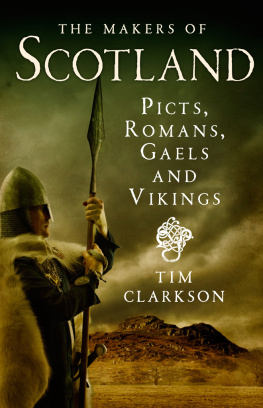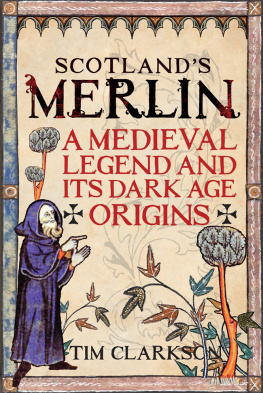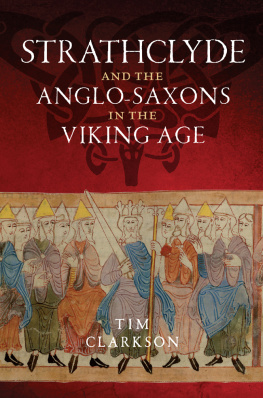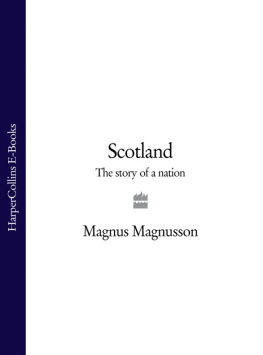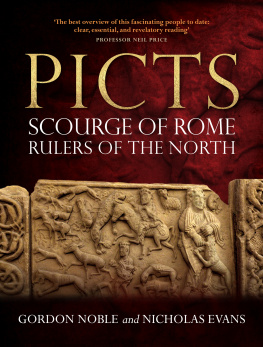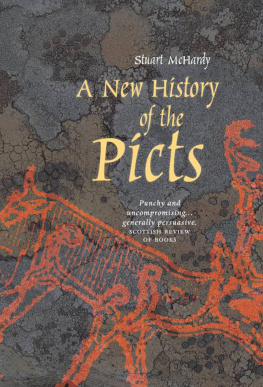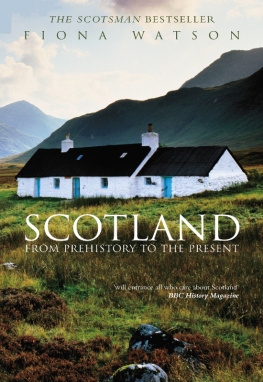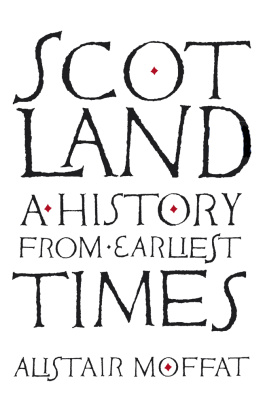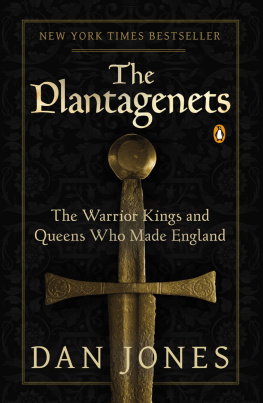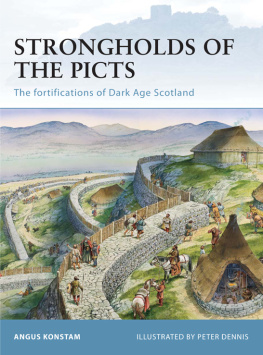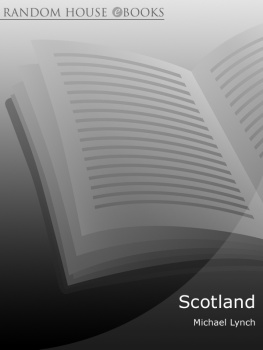
This eBook edition published in 2012 by
Birlinn Limited
West Newington House
Newington Road
Edinburgh
EH9 1QS
www.birlinn.co.uk
Copyright Tim Clarkson 2011
First published in 2011 by John Donald, an imprint of Birlinn Ltd
The moral right of Tim Clarkson to be identified as the author of this work has been asserted by him in accordance with the Copyright, Designs and Patents Act 1988
All rights reserved. No part of this publication may be reproduced, stored or transmitted in any form without the express written permission of the publisher.
ISBN: 978-1-906566-29-6
eBook ISBN: 978-1-907909-01-6
British Library Cataloguing-in-Publication Data
A catalogue record for this book is available from the British Library
List of Maps

Introduction
Objectives
This book aims to provide a narrative history of Scotland from the eve of the Roman invasion to the final phase of the Viking Age. It encompasses one thousand years of social, political and religious development in which various groups and individuals each played their part. The books subtitle names four of these groups Picts, Romans, Gaels and Vikings all of whom contributed to the shaping of Scotlands medieval identity. Two others the English and the Britons are intentionally absent from the subtitle. Their omission does not diminish their role in the narrative. Indeed, both peoples were major players in early Scottish history and are accorded due prominence in the following chapters. Omitting them from the subtitle is rather an acknowledgement that their names convey no specific sense of time and place to the reader. By contrast, the mention of Romans and Vikings indicates the broad chronological context, while the naming of Picts and Gaels emphasises that this is a book about Scotlands ancient inhabitants. The narrative begins at the end of the first century BC . in the years when Rome began to take a keen interest in the British Isles. It then follows a chronological path, tracing Scotlands origins through the ensuing centuries to the battle of Carham-on-Tweed in 1018.
This is not a study of topics or themes. Broad subjects such as warfare and economics are incorporated within the narrative, but the main purpose of the book is to present a linear history. The sole exception to this rule is Christianity, a topic forming the main focus of three chapters which together chart the decline of paganism, the establishment of churches and the increasing role of the clergy in political affairs. Chapter narratives are not punctuated by citations of primary and secondary sources, or by footnotes and endnotes, but the closing pages of the book include suggestions for further reading on particular topics. Throughout the book a number of maps indicate the locations of kingdoms, settlements, religious sites and other significant places. Genealogical tables in Appendix A show the kinship between important individuals, while Appendix B provides a chronological summary or timeline.
Sources
The period covered by this book includes the three and a half centuries of Roman rule in Britain, from AD 43 to c.400, plus a further six hundred years which eventually saw the northern part of the island evolve into the Gaelic-speaking kingdom of Alba. Only a segment of what is now Scotland was brought within the Roman Empire, but the unconquered portion remained a source of trouble for the imperial authorities despite many attempts to subdue it. Military campaigns launched against the northern peoples were documented by Roman writers whose accounts represent a rich vein of data on early Scottish history. After the Empire abandoned Britain in the early fifth century, Roman texts effectively ceased to mention Scotland, their disappearance depriving modern historians of a contemporary record of events. Sparse information relating to the fifth and sixth centuries does exist, but much of it was created retrospectively by writers of a much later era who were less interested in historical accuracy than in reconfiguring the past in ways appropriate to their own purposes. This means that todays historian must sift each textual source very carefully, in the hope of unearthing fragments of genuine early information among passages written in the twelfth or thirteenth century or even later.
Reliable sources from the first millennium AD are scarce and are usually biased in favour of political or religious interests. A typical example is Bede, a northern English monk whose lifetime spanned the seventh and eighth centuries. Not long before his death in 735 he completed his greatest work, The Ecclesiastical History Of The English People, in which he frequently made reference to the peoples of early Scotland. His book is a valuable contemporary source and a repository of fascinating detail, but, notwithstanding his reputation as a meticulous scholar, the Ecclesiastical History needs to be treated with caution. Bede was not a historian in the modern sense, but a monastic writer who regarded history as the unfolding revelation of events predetermined by God. This meant that he constructed his narrative in ways that allowed him to demonstrate how the English whom he believed to be a chosen people like the Israelites of the Old Testament enacted Gods will among themselves and their neighbours. In so far as the peoples of early Scotland were concerned, Bede saw some such as the Picts as playing a positive role in the Divine plan, while others such as the Britons, whom he regarded with contempt were earmarked by God to suffer well-deserved woes at the hands of English enemies. The Ecclesiastical History is therefore coloured by its authors biases and preferences and is not the sober textbook it might seem at first glance.
Contemporary sources written in Scotland are few in number. There is no Scottish equivalent of Bede and only a handful of eyewitness or near-contemporary accounts relating to this period have survived from northern Britain. This does not mean that reliable information cannot be found, but the task of identifying it is made more difficult. Our most detailed source is a group of texts known collectively as the Irish annals. Originating as year-by-year entries in records maintained by monasteries, these texts refer not only to ecclesiastical matters but also to events in the secular world. Although the various manuscripts in which the annals survive were written no earlier than the twelfth century, their information was copied from older documents and can be traced back to lost texts compiled many centuries earlier. One of the lost compilations was a set of annals maintained at the Hebridean monastery of Iona, a religious settlement established by the Irish priest Columba in the sixth century. The annals were destroyed when Iona fell prey to Viking raids, but a number of entries were incorporated into the two main Irish compilations the Annals of Ulster and the Annals of Tigernach to preserve a valuable account of Scotlands early medieval history. Ionas annalists had a keen interest in political affairs and noted important events such as battles, alliances and the deaths of kings. Like Bede, however, they were not immune from bias and crafted their words carefully, selecting events they wished to write about and ignoring others. After the middle of the eighth century, the Iona entries in the Irish annals cease, but Scottish information continued to be recorded in Ireland throughout the Viking period and beyond. Some of this data was spurious or inaccurate, or was added to the annals retrospectively, or was amended much later by scribes when manuscripts were being copied. Rigorous modern analysis of the surviving texts has revealed numerous problems and pitfalls but has enabled the older, more reliable entries to be identified, thereby allowing the Irish annals to be used as a valid source for early Scottish history.
Next page
